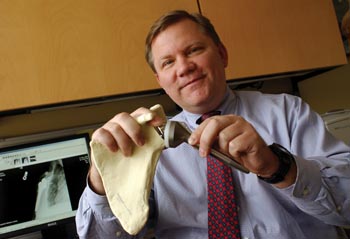
John Kuhn, M.D., demonstrates new shoulder replacement technology that helps relieve pain and restore function for some patients.
Photo by Dana Johnson
‘Last resort’ surgery holds promise for shoulder patients
A severely torn rotator cuff has traditionally translated into a lifetime of nagging pain for patients and a limited range of motion that's mostly beyond repair for surgeons.
But Vanderbilt University Medical Center's John Kuhn, M.D., associate professor and chief of Shoulder Surgery in the Department of Orthopaedics, is now offering the prospect of a “last resort” measure in certain cases.
Called “reverse ball and socket arthroplasty” (joint replacement), Kuhn is placing the shoulder ball and socket replacement in their anatomical opposite positions in order to relieve pain and restore function to the shoulder.
“There is such a demand for this because so many patients were in a situation where nothing could be done for their shoulder and they were in pain and had poor function,” said Kuhn, one of only three surgeons in Tennessee performing the procedure.
“When this implant came on the market it became a very big seller because there was a backlog of patients waiting for this kind of solution to their problem.”
Kuhn has performed the new technique on 14 patients during the past 18 months, with results better than the 25 percent to 30 percent re-operation rate reported from European trials.
“When I speak to patients I want them to understand that this is not a perfect solution,” Kuhn said. “It does help with pain and it does help give them better function, so it takes people who were in very bad shape and makes them better, but not perfect.
“And because the complication rate is high I really want to be sure patients understand what they are getting into,” he added.
Complications that have been described with this implant include infections, dislocations, loosening and wear. Only one of Kuhn's patients has required a re-operation.
“So far I'm beating the odds. This is a salvage implant so it's not something that we like to use haphazardly,” he said.
“With a complication rate that high, you could ask, 'Why would you use it?' but really the worst-case scenario is, if it fails miserably and you take the whole thing out, you are left with a painful shoulder that doesn't work very well. And that's what the typical patient had before the implant.”
If the two-hour surgery is successful the shoulder pain goes away quickly and the shoulder begins to function, but with the deltoid muscles now doing the work of the rotator cuff.
The surgery, which originated with designs in France roughly a decade ago, is geared toward elderly patients with a disease called rotator cuff tear arthropathy, when the rotator cuff tear is so bad it causes arthritis.
Other candidates for the surgery include rotator cuff patients who have had multiple surgeries, fractures or joint replacements that have failed.
Most patients spend one night in the hospital after the surgery and start therapy after about two weeks. Kuhn estimates patients can have full use of their shoulders within three to six months after the operation.
Nashville resident Greta Faye Mason, 71, had Kuhn perform the surgery on her right shoulder and is considering the same procedure for her left shoulder.
She said a career of caring for and lifting patients in the home health industry, coupled with tasks such as taking out the trash that she took over when her husband passed away, literally wore out both of her shoulders.
“I could not keep lifting and turning by myself,” she said. “I even had to give up working because of my shoulders.”
Her situation has improved dramatically since her Aug. 9 procedure.
“It is doing great,” Mason said. “I can wash my back, I have been putting my arm behind my back for some time now. And the reaching is good; the shoulder is getting its strength back.
“It was just amazing. And actually the recuperation was easier than the repair itself. There was not as much therapy involved either. There is only so much you can do; it didn't take long at all for the pain to go away. It was so helpful, so much better.”













